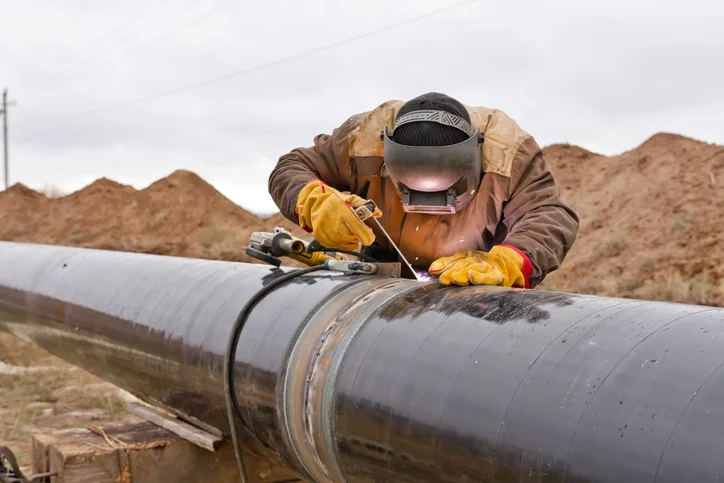Optimize Performance: Proactive Pipeline Welding Inspection Approaches
Optimize Performance: Proactive Pipeline Welding Inspection Approaches
Blog Article
Vital Pipe Welding Inspection Tips for Quality Assurance
Just how can one guarantee the top quality of these welds that link the pipe sections? By recognizing the vital pipe welding evaluation pointers, specialists can prevent possible risks, lower expensive fixings, and support the integrity of these crucial frameworks.

Importance of Welding Assessment
Welding evaluation plays a critical function in ensuring the structural honesty and security of pipe systems. By carefully checking out welds, inspectors can determine any problems or blemishes that could jeopardize the honesty of the pipeline. These assessments are important for stopping leakages, ruptures, and other possibly catastrophic failures that might cause environmental damage, economic losses, and also loss of life.
The significance of welding examination can not be overstated, as the quality of welds directly influences the total performance and longevity of the pipeline. With non-destructive screening approaches such as aesthetic evaluation, ultrasonic testing, radiography, and magnetic fragment screening, assessors can spot problems that might not show up to the nude eye. By identifying and dealing with these problems beforehand, welding examination helps to ensure that pipelines meet market requirements and regulative demands.
Eventually, welding assessment is a critical facet of quality control in pipe upkeep, repair work, and building (Pipeline Welding Inspection). By maintaining strenuous assessment requirements, industry professionals can minimize dangers and maintain the safety and reliability of pipe systems
Typical Welding Problems
Among the difficulties encountered in pipe welding, common flaws can dramatically impact the structural stability and efficiency of the bonded joints. Splits in the weld can propagate over time, compromising the structural stability of the pipe. Detecting and dealing with these typical flaws via detailed inspection and quality control processes are vital for making certain the integrity and safety and security of pipe welds.
Inspection Techniques for Pipelines

In ensuring the structural integrity and reliability of pipeline welds, the application of extensive assessment methods is vital. Numerous examination approaches are used to detect potential flaws and ensure the overall quality of the welds. Non-destructive screening (NDT) strategies such as radiographic screening, ultrasonic screening, magnetic bit screening, and liquid penetrant testing are commonly utilized in pipe welding examination. Radiographic screening entails the usage of X-rays or gamma rays to find interior problems, while ultrasonic testing uses high-frequency acoustic waves to recognize flaws. Magnetic bit testing is effective for identifying surface-breaking issues, and fluid penetrant testing is used to identify surface area splits. Visual evaluation is also essential in pipe welding to determine any noticeable flaws or gaps. Additionally, computerized evaluation strategies using advanced modern technologies like drones and robotics are progressively being employed to improve the efficiency and precision of additional hints pipeline examinations. By utilizing a combination of these assessment techniques, pipe weld top quality can be guaranteed, and possible problems can be minimized prior to they intensify right into larger troubles.
Ensuring Top Quality Guarantee Criteria
To support rigid top quality guarantee criteria in pipe building and construction, meticulous adherence to established industry protocols and guidelines is important. Quality guarantee in welding procedures needs a detailed strategy incorporating numerous phases of pipe building. Carrying out a robust quality management system that includes regular audits and testimonials can better boost the general high quality assurance standards in pipeline welding.
Preventing Pricey Fixings
Given the crucial significance of preserving rigorous top quality assurance standards in pipeline construction, a positive method to stopping expensive fixings is crucial. Normal upkeep checks and surveillance of ecological variables that might impact the honesty of click here to find out more the pipeline look at this website are additionally essential in avoiding expensive repair work. By investing in preventative steps and prioritizing quality assurance at every phase of the pipe welding procedure, business can reduce the risk of expensive repairs and ensure the lasting integrity of their facilities.
Final Thought
Finally, adherence to proper welding inspection strategies is crucial for making certain the high quality and integrity of pipelines. By recognizing typical welding problems and implementing thorough inspection procedures, expensive repairs can be protected against, and high quality assurance criteria can be satisfied - Pipeline Welding Inspection. It is important for pipeline welders to focus on evaluation treatments to preserve the safety and integrity of the infrastructure they are servicing
The value of welding inspection can not be overemphasized, as the quality of welds straight affects the total performance and long life of the pipeline. Non-destructive screening (NDT) techniques such as radiographic screening, ultrasonic testing, magnetic fragment testing, and fluid penetrant screening are typically made use of in pipeline welding examination. Visual examination is also crucial in pipeline welding to determine any visible issues or gaps. In addition, automated assessment techniques using innovative technologies like drones and robotics are significantly being employed to improve the performance and precision of pipeline assessments.In verdict, adherence to proper welding evaluation strategies is essential for guaranteeing the high quality and honesty of pipes.
Report this page